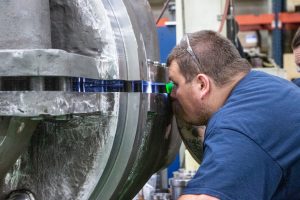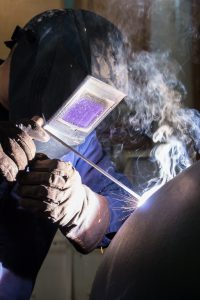 What constitutes a quality pump repair? Quite simply, Hydro pays attention to the details – a thorough inspection process, extensive process control procedures, stringent acceptance criteria, engineering support, and review – all carried out by an experienced workforce dedicated to providing a quality product.
What constitutes a quality pump repair? Quite simply, Hydro pays attention to the details – a thorough inspection process, extensive process control procedures, stringent acceptance criteria, engineering support, and review – all carried out by an experienced workforce dedicated to providing a quality product.
Inspections: Hydro’s very thorough and detailed inspection process is the foundation of quality repair that can prevent recurring problems, extend pump life and reduce long-term repair costs. During the inspection process, we often uncover issues that, if left unattended, could result in premature failure of a component and the pump.
The inspection of a multi-stage pump can involve taking over 900 separate readings. Not only do we record dimensional data, but we also take extensive hardness readings on the impellers and analyse the hydraulic passageways for appropriate A & B Gap dimensions.
The inspection process and the report of our findings is a great opportunity for Hydro engineers and technicians to work with the customer’s maintenance team to discuss options for not only repairing but for improving the pump’s performance and reliability.
Rotor Centralisation: In Hydro’s drive to increase pump reliability and extend pump life, we have pioneered a number of engineering improvements, including a process we refer to as Rotor Centralisation. Hydro has found that in many cases the impeller and diffuser centrelines of diffuser-style pumps are not lined up. This causes turbulent flow, which results in hydraulic instability, vibration, increased stress on all components, and reduced efficiency.
To correct these problems, Hydro performs a detailed dimensional analysis to establish the centreline relationship of the pump’s stationary and rotating components. The rotor is then modified to ensure centreline compatibility at each stage of the pump.
Rotor Balancing: Dr. Elemer Makay – a foremost authority on high energy pumps, with whom we worked for over 20 years – consistently emphasised the importance of maintaining a stringent balancing standard for high-energy pumps. Achieving this high standard requires much more stringent repair standards and acceptance criteria.

The benefit of achieving 1 W/N rotor balance is significantly reduced vibration levels that should dramatically decrease premature bearing and ring wear and substantially increase the MTBR of the pump. It is not unusual for multi-stage pumps repaired by Hydro to these stringent standards to experience a life of 11 years without degradation in efficiency.
